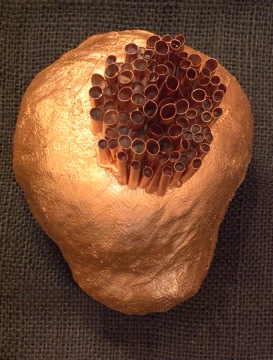
Sculpture by Julian Silverman
Ever since the blog post Jessica Hamlin wrote a few weeks back regarding my “Teaching About Power” unit I’ve been feeling a little guilty. Don’t get me wrong, I’ve gotten wonderful e-mails and phone calls. The video turned out really well. The footage looks excellent. The students are articulate about their work, and the art work makes some powerful (?) statements about power itself.
I just wish all units went that well.
So to satisfy my need for, oh, I don’t know, full disclosure, I want to share some stories over a few columns about units that didn’t go well and the things that happened as a result.
Prior to teaching high school and college courses, I spent eleven years teaching middle school and I wouldn’t trade the experience for anything in the world. Teaching middle school students taught me a ton about management- both classroom and behavior- and it allowed me to, quite frankly, get back inside an adolescent’s mind from time to time. My first Not-So-Powerful story involves a group of 7th graders getting caught up in my initial excitement over installation art. We were learning about various forms of three-dimensional sculpture, the conversation got to this new form of sculpture called installation, and everyone was suddenly psyched to create one. In less than a full class period, I managed to map out how 30+ kids were going to create installations all over the school building in the next week. I felt like a genius. I remember driving home feeling so satisfied that FINALLY, we would have some contemporary art gracing the school. Real stuff!
The week started out fine. One installation involved creating an abstract solar system in plaster. Another focused on a series of footprints that went to mysterious, less visited places in the building.
Then the clocks were attacked.
Two students, on their own time, with their own materials, decided to very carefully place large, brightly colored “dots” over each and every clock in the school. No face was spared. Even the wall clock in the Principal’s office (and I still don’t know how they snuck in there) was covered. Unless you were wearing a watch, you had no idea what time it was because these two students had, in a sense, taken away time. It took exactly one class period before I began getting phone calls.
“Joe, do you know that your students have covered up all the clocks in the building?” one teacher asked.
“How am I supposed to get them cleaned up in time if I don’t know what time it is?!?!” another insisted.
“Joe, I love your ideas, but this one went too far,” my Assistant Principal said.
While the idea was a good one- students wanted to see how much we depend on always knowing the time- it was an idea that interrupted the flow of the school day. And while the dots had to come off after school, the students and I were satisfied that we got a sense of how so many people relied heavily on knowing, minute to minute, “how many minutes they had”.
Since teaching that particular unit, I have made a few changes whenever I go about teaching anything involved with installation. First, I tell everyone about what’s happening, and I don’t so much “tell” as ask if the project would be ok with the school community. Second, I ask for sketches and written proposals from my students to help them work out logistics and troubleshoot any possible problems before they arise. Third, we always conduct an in-progress critique before the installations go up, just in case another student(s) has ideas to make the work even better before it “goes public”.
For every “power” unit like the one featured in the video, there are many, many units that made wrong turns and went wildly off track. More to come. Once September gets rolling I’d like to share a few other stories.
Next week…. Reflecting on Mark Slouka’s “Dehumanized”.




Pingback: What’s Cookin at the Art21 Blog: A Weekly Index | Art21 Blog
Pingback: The dubious value of art education | Stephanie Vegh
Pingback: Teaching with Contemporary Art: The First Three Years | Art21 Blog